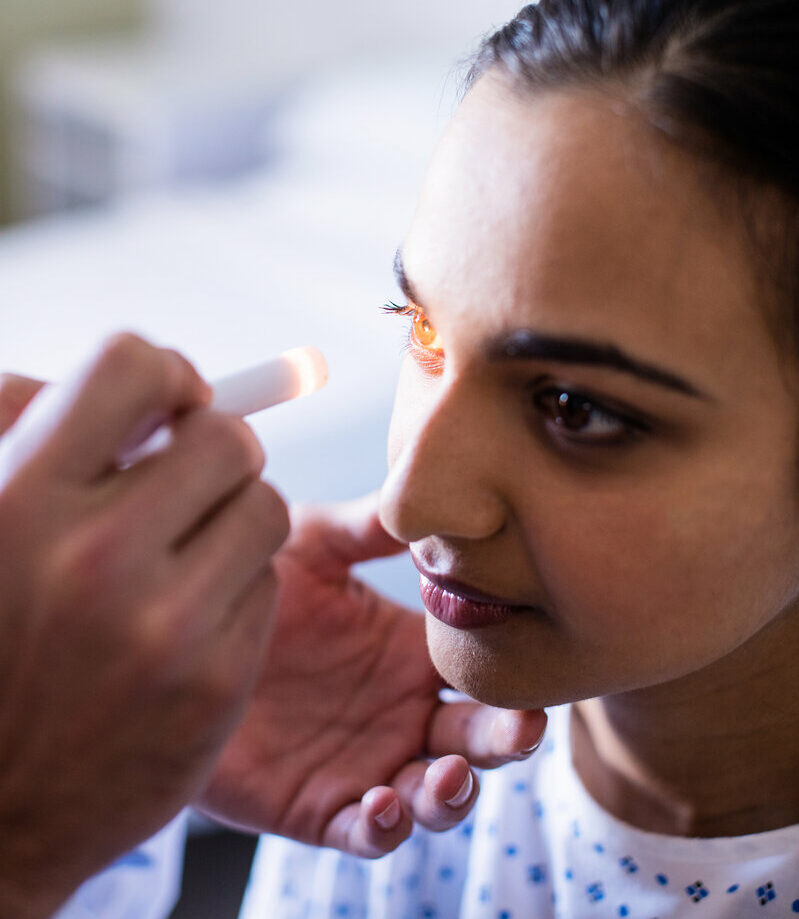Posted by: Atlantic Eye Institute in Education

Wearing sunglasses may be stylish, but it’s also necessary for those who spend ample time outdoors. Ultraviolet (UV) rays from the sun can cause temporary and permanent damage to the eye and your vision. A pinguecula is a red flag, indicating your eyes need more protection than you’re giving them.
A pinguecula can also result from tissue trauma due to excessive exposure to wind and sand, which is another reason wearing wrap-around sunglasses or safety glasses is a must if you spend a significant amount of time outdoors.
Symptoms & Diagnosis Of A Pinguecula
A pinguecula begins as a small bump on the white of the eye (conjunctiva) and grows larger over time. It is cream or yellowish. Pingueculae (the plural of pinguicula) usually develop on the inner eye, close to the border of the iris (colored part of the eye). They are made of protein, fat, calcium, or a combination of any of those.
The first symptoms of a pinguecula are:
- A feeling that something is in the eye
- Visible swelling of that bump, which you may first mistake as eye allergies
- Red or irritated eyes
- Excessive watering
Pingueculae can develop in more than one eye, and some people have more than one in the same eye. Scheduling an appointment with your optometrist is the first step to determining if you have a pinguecula. Next, we’ll take a close look at the surface of your eye to quickly determine if a pinguicula is the cause of any eye irregularities or discomfort.
Risk Factors For Developing A Pinguecula
Most of the time, patients with pinguecula experience lots of daytime sun exposure without wearing proper eye protection. And, don’t forget that excessive sun and UV exposure is an extra risk for those who spend time on or near the water and snowy winter climates, which is why sun protection is as important during the winter as it is during the summer.
Some of the most common risk factors include:
- Working outside (farmers, contractors, field workers, road crews, etc.)
- Participating in water or snow sports
- Being male (men tend to develop pingueculae more often than women)
- Age
Make eye protection a priority when working or playing outdoors. This means:
- Wearing sunglasses with high UV protection ratings
- Speak to your optometrist about prescription safety glasses if you wear them at work
- Always wearing a wide-brimmed hat
- Taking advantage of shady areas whenever possible
- Work/play during off-peak sun hours if you can (Florida’s peak UV concentration spans the hours between 10 a.m. and 2 p.m.)
If you suspect you have a pinguecula, soothing eye drops can help with the irritation. In the meantime, it’s critical that you protect your eyes to prevent further growth. Over time, a pinguecula can grow larger enough to cover the cornea. At that point, it is called a pterygium (commonly called “surfer’s eye”). Unfortunately, pterygiums can cause permanent eye damage and vision loss, so quick treatment of your pinguecula is a must.
Pinguecula Treatment Options
The sooner you get a diagnosis the better. If the pinguecula is small enough, it may reverse and clear up with proper attention and treatment. But, first, you need to be faithful about using sun protection to prevent any further development of the pinguecula and the development of new growths on either eye.
Relief from pinguecula irritation and inflammation: drops, gels, creams, and steroids
Your doctor will also prescribe eye drops, gels, or cream to reduce eye irritation and existing inflammation. You may sometimes get a prescription for steroidal eye drops, which further reduce inflammation. Hopefully, with consistent protection and relief from irritation, the pinguecula will cease growing and recede.
Surgical/laser intervention
If the growth is so large that drops or steroid options don’t work, or if it grows so large it threatens to cover the cornea, your optometrist may suggest surgical intervention. In this case, you’ll get a referral to an ophthalmologist. This is most likely when:
- The growth becomes thick or painful
- It affects how you blink
- A pinguecula pulls on the cornea
- You experience extreme discomfort when wearing contacts lenses
- You’re bothered by the physical look of the pinguecula
In most cases, we use a laser surgery procedure to remove the growth. These surgeries are done here in our office. There is minimal risk of complication, and patients heal quickly with prescription antibiotic eye drops and a little TLC to prevent infection in that first week.
Once a pinguecula is removed, it can come back. Sun protection is your first line of defense to prevent the recurrence of a pinguecula. Your ophthalmologist may also recommend surface radiation to prevent its recurrence. Usually, we use surface radiation to get rid of cancerous cells in the eye. However, it can also eliminate damaged cells that may lead to the growth of another pinguecula.
Suspect You Have A Developing Pinguecula?
Time is of the essence if you suspect you are developing a pinguecula. Don’t wait to see if it gets work. Instead, schedule an eye appointment with Atlantic Eye Institute. A quick exam is all we need to determine if a pinguecula is causing irritation, discoloration, or inflammation in your eye.
Once we’ve made a diagnosis, we’ll work with you to create a treatment plan that is best for the severity of the condition and your comfort. Schedule an eye appointment online or give us a call at (904) 241-7865 to get started.



